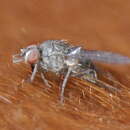en
names in breadcrumbs


This species is thought to have been introduced to North America from Europe in cattle shipments.
Haematobia irritans requires no special conservations status.
US Federal List: no special status
CITES: no special status
A serious pest of cattle, H. irritans can cause cows to lose weight and lower milk production by biting while the cows attempt to feed. Cattle spend time trying to relive themselves of irritation rather than eating. Thousands of H. irritans can be present on a single cow, causing that cow extreme discomfort. In addition to simply bothering cattle, H. irritans is capable of transmiting the nematode Stephanofilaria stilesi. This nematode causes damage to the skin of cows. Attempts have been made to eradicate H. irritans using pesticides. Unfortunatley, resistant populations of H. irritans emerge within a few weeks after treatment begins.
Negative Impacts: causes or carries domestic animal disease
There are no known economic benefits derived from this species.
Haematobia irritans, while able to fly almost never leaves its host, instead staying on the same cow to feed 24 hours a day. Adult Haematobia irritans is an ectoparasite, found all over the skin of cattle. It is a telmophage, using its labella to pierce the skin of a cow, so that the fly may suck up the blood that flows into the wound. Larvae feed on the feces of large ungulates.
Animal Foods: blood
Other Foods: dung
Primary Diet: carnivore (Sanguivore ); coprophage
Haematobia irritans is found on the continents of North and South America, Asia, Africa and Europe. In North America, H. irritans lives year round in the Sourthern United States, while in the summer months it ranges north into Cananda.
Biogeographic Regions: nearctic (Native ); palearctic ; ethiopian ; neotropical ; australian
In North America, pastures containing herds of large mammals are the typical habitat of H. irritans.
Habitat Regions: temperate ; tropical
Terrestrial Biomes: savanna or grassland
Other Habitat Features: agricultural
Adults are quite small, approximately half the size of a house fly. Haematobia irritans is gray in color with the large compound eyes and reduced antennae typical of flies in the infraorder Muscomorpha. Larvae of H. irritans are approximately 7mm long. The maggots are a pale yellow color, with a simple, elongate, body that lacks a sclerotized head. A pair of sclerotized, vertically biting mandibles are visible on the anterior end of the head.
Average length: 7 mm.
Other Physical Features: ectothermic ; heterothermic ; bilateral symmetry
The predatory larvae of several other species of insect, including beetles of the family Staphylinidae, prey upon the larvae of H. irritans. In order for H. irritans larvae to have a chance to develop, their eggs must be laid quickly; before those of other insects.
Known Predators:
Gravid females lay approximately 18 eggs in groups of 4-6 on fresh cattle droppings. Larvae hatch within 24 hours and begin feeding. After five days, the larvae have passed through three instar stages and are ready to pupate. Adults emerge from the puparium five days later. In colder climates, however, the life cycle of H. irritans may take up to three weeks for completion.
Average eggs per season: 18.
Key Reproductive Features: semelparous ; sexual ; fertilization (Internal ); oviparous